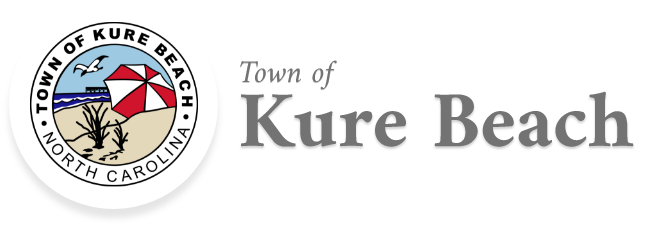Flood Prevention
Flooding is a major concern to the Town of Kure Beach. Since we are an oceanfront community, we are more susceptible to the havoc that comes with hurricanes, king (full moon) tides, and Northeaster winds.
Since 1979, Kure Beach has participated in the National Flood Insurance Program (NFIP) which allows property owners to procure Federally backed insurance policies.
Kure Beach also participates in the Community Rating System (CRS). CRS is a part of the NFIP, and its purpose is to recognize, encourage, and reward, by the use of flood insurance premium adjustments, community and state activities that are above and beyond the NFIP required minimum standards.
If you have questions about flooding, please contact Building Inspector Bethany White. She will be happy to discuss any concerns you have, and will meet you on your property.
North Carolina Flood Risk Information Center – sea what flood zone you’re in!
Avoid Hurricane Damage
- Install and maintain storm shutters
- Install a generator for emergencies
- Anchor or remove potential wind-borne objects
Tips to Build Responsibly in Kure Beach
- Determine if the lot and building presently meet the setback for new construction
- Always check with the Inspections Department before you build on, alter, degrade or fill on your property
- Report illegal building or filling to the Building Department at (910) 458-6535
- If you are in the process of, or planning on, building or retrofitting your home or business in a coastal flood hazard area, have your architect / engineer or contractor use the Federal Emergency Management Agency’s technical resources for Residential Coastal Construction.
Drainage System Maintenance Regulations
- No dumping
- Check your downspout-drain away from the house
- Protect our natural resources and protect yourself from flooding due to drain blockage by reporting illegal activities to (910) 458-6535
- Only rain goes down the drain
About Insuring Your Property
- Typically, there is a 30-day waiting period from date of purchase before your policy goes into effect
- Being insured is one of your best forms of protection
- To find out more about flood insurance, contact any licensed insurance agent
- Flood insurance is available to almost everyone
- Flood policies are available to homeowners, condo owners, apartment owners, renters and business owners
- Questions you should ask as a potential purchaser of coastal real estate can be found at NCREC “Questions and Answers on” Purchasing Coastal Real Estate in North Carolina”.
- Learn the essentials to flood insurance, including what it covers, what it protects and who it protects at Flood Smart.
Know Your Flood Hazard - Coastal Zones / LiMWA
- There are three basic coastal zones and one new zone in the new NFIP maps:
- The flood zone X is considered to be a low risk of flooding.
- VE zones or Coastal High Hazard Areas are zones where high velocity wave action accompanies the storm surge and can cause severe damage to buildings.
- AE zones are areas affected by storm surge but where wave action is diminished or absent.
- For the first time FEMA has established another area within the AE zone called the Limit of Moderate Wave Action or LIMWA. These moderate waves can cause damage to buildings, though they are not as damaging as the waves expected in the VE zone. Communities that adopt the Limit of Moderate Wave Action as a higher regulatory standard may earn flood insurance rate discounts.
- Before buying, you should be aware of other factors that accompany the pleasures of owning property near the beach.
- To determine your flood risk, visit FloodSmart.gov or call 800-358-9616
- For information from the Federal Emergency Management Agency’s Flood Insurance Rate Map (FIRM) and floodplain management questions, contact the Inspections Department at (910) 458-6535
- Use the MSC through the North Carolina Flood Map website to find your official flood map
Protecting People
- Prepare your family
- Do not walk through flood waters
- Do not drive through a flooded area
- Stay away from power lines and electrical wires
Turn Around, Don’t Drown! - Pay attention to barricades. Don’t ignore them by driving past them
- Do not drive through standing water on roads or in parking lots
- The average automobile can be swept off the road in 12 inches of moving water, and roads covered by water are prone to collapse
- Attempting to drive through water also may stall your engine, with the potential to cause irreparable damage if you try to restart the engine
- If you come upon a flooded street, take an alternate route
Protect your Property
- Determine the floor elevation relative to local flood predictions
- Use flood damage-resistant building materials for all construction below the BFE susceptible to flooding
- Do not convert the space below BFE to habitable space. Use the space below BFE solely for parking of vehicles, building access, or storage
- Protect against high winds by installing storm shutters and reinforcing garage doors
- The best way to protect your home is through the National Flood Insurance Program
- Thousands of homeowners thought it would never happen to them. Don’t be one of those homeowners
Protect the Floodplain
- Protect the Natural and Beneficial Functions of the Floodplain
- For information about areas that should be protected because of their natural floodplain functions contact the Inspections Department at (910) 458-6535
- Report unauthorized activities to the Inspections Department at (910) 458-6535
Activity 420 (Open Space Preservation) / Activity 510 (Floodplain Management Planning). - Support Keep Onslow Beautiful.
- Give a hoot, don’t pollute!
To learn more about the importance of protecting floodplains for people and wildlife, visit the National Wildlife Federation website.
